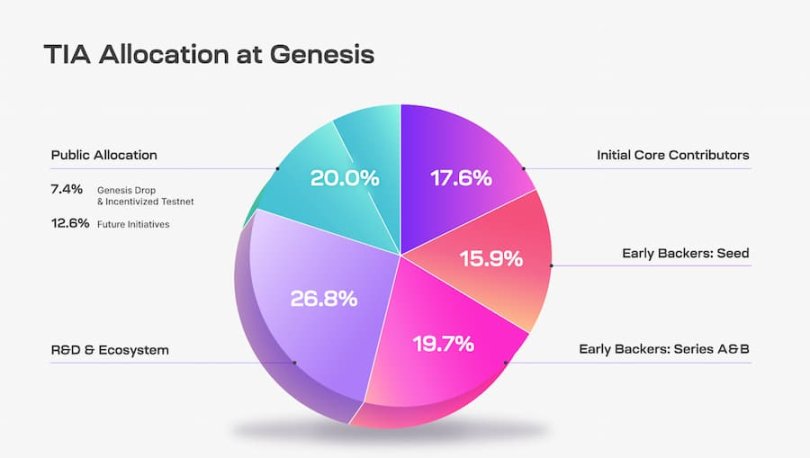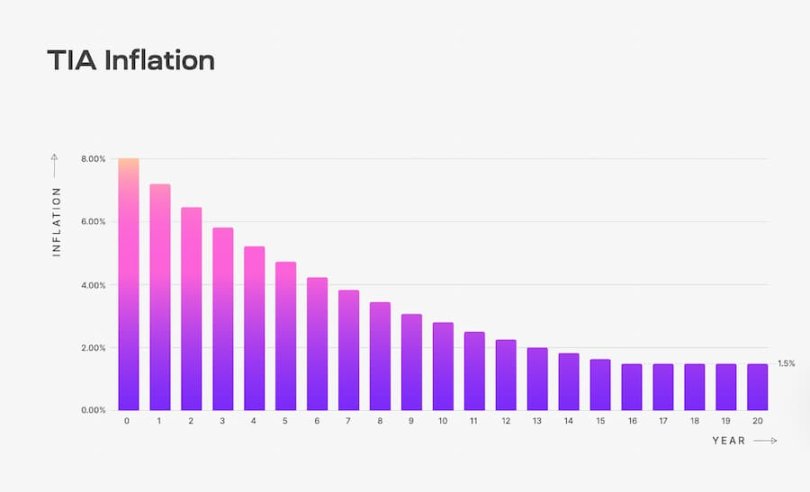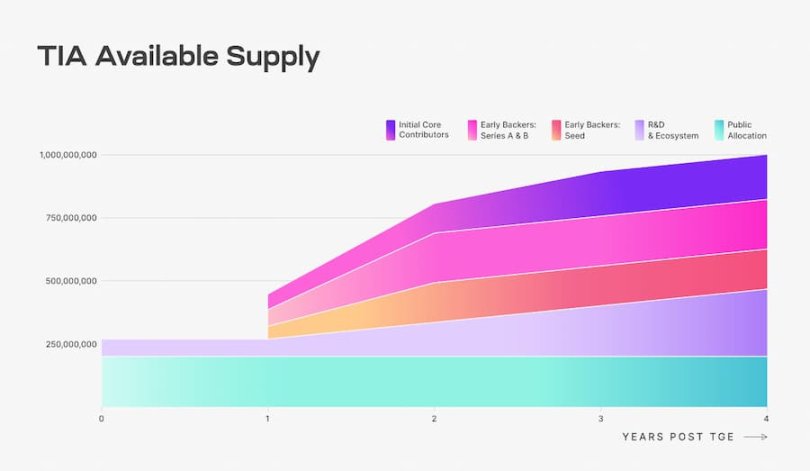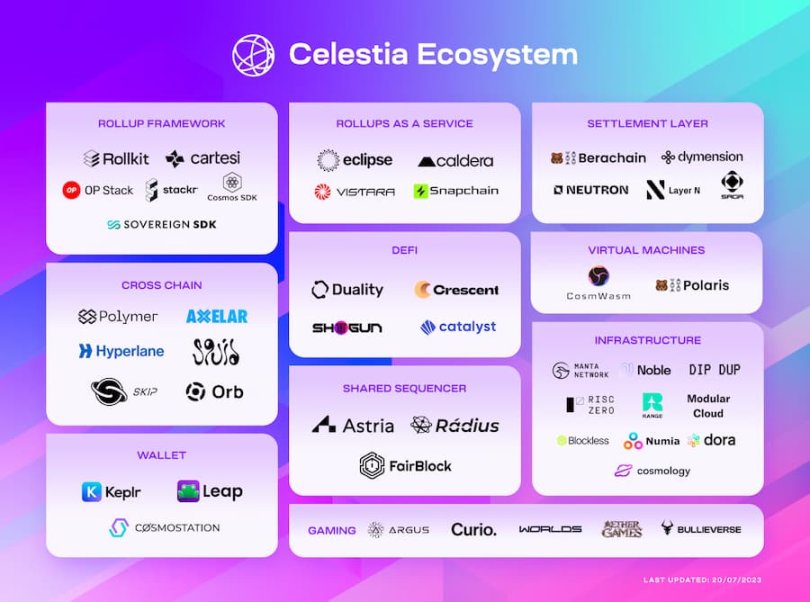Celestia, a modular blockchain, launches its own cryptocurrency. Take a quick look at the airdrop details and token economy.
Celestia, a modular blockchain, launches its own cryptocurrency with airdrop details and token economy.Source: Celestia
Translation: Karen, Foresight News
Today, modular blockchain Celestia announced the release of its native token TIA and the launch of the Genesis Drop. The Genesis Drop will be distributed to 7,579 developers and 576,653 on-chain addresses on Ethereum Rollups, Cosmos Hub, and Osmosis. The airdrop will be distributed among developers, ecosystem project contributors, ordinary users, and stakers, among others.
Celestia is an proof-of-stake blockchain based on CometBFT and Cosmos SDK. Celestia supports delegation within the protocol and will start with a set of 100 initial validators. Staking TIA as a validator or delegator will allow participants to earn staking rewards from the network. Validators can also charge fees to delegators, thereby earning a proportion of the staking rewards.
- Why is regulatory compliance considered the final step in decentralization for blockchain?
- SBF in the eyes of Western mainstream media Watch the BBC documentary ‘The Fall of the Crypto King’ in 5 minutes.
- How does composability enhance the openness of the autonomous world?
So what is the utility of the native token TIA? What are its token economics and release rules? And what are the criteria for the airdrop?
Utility of TIA
Firstly, TIA is an important component for developers to build modular data availability networks. In order to use Celestia for data availability (DA), Rollup developers need to submit LianGuaiyForBlobs (PFB) transactions on the network and pay a certain fee in TIA.
Secondly, similar to ETH on Ethereum-based Rollups, developers can choose to use TIA as the gas token to quickly launch their chains in addition to paying for data availability. In this mode, developers can focus on creating applications or execution layers without needing to issue tokens immediately.
Lastly, as a permissionless network built using Cosmos SDK, Celestia uses proof-of-stake to ensure consensus. Like other Cosmos networks, any user can earn a portion of the validator’s staking rewards by delegating their TIA to Celestia validators, thus helping to secure the network. TIA also allows the community to play a crucial role in the decentralized governance of key aspects of Celestia from day one, such as voting on network parameters and managing the community pool.
In the community pool, from the launch of the network, 2% of all Celestia block rewards will go to the Celestia community pool. TIA holders can vote to spend TIA from the community pool to fund ecosystem initiatives.
TIA Token Economics
The total initial supply of TIA is 1 billion, with the specific allocation as follows:
- Public distribution: 20% (7.4% for Genesis Drop and incentive testnet distribution, 12.6% for future incentive distribution), fully unlocked upon release;
- Allocation to Celestia Foundation and core developers for research, development, and ecosystem initiatives: 26.8% (25% unlocked upon release, remaining 75% unlocked from year 1 to year 4);
- Allocation to seed round early investors: 15.9% (33% unlocked in the first year, remaining 67% unlocked from year 1 to year 2);
- Allocation to Series A and Series B early investors: 19.7% (33% unlocked in the first year, remaining 67% unlocked from year 1 to year 2);
- Allocation to initial core contributors: 17.6% (33% unlocked in the first year, remaining 67% unlocked from year 1 to year 3).
The TIA inflation rate starts at 8% per year and decreases by 10% each year until it reaches a long-term issuance rate of 1.5%. The exact annual inflation rate is shown in the following figure.
In terms of token release and supply changes, Celestia’s initial supply of 1 billion TIA tokens will be constrained by several different unlocking schedules. All locked or unlocked tokens can be staked, and staking rewards are unlocked upon receipt.
Celestia Genesis Airdrop
The Celestia Genesis Airdrop will be distributed to 7,579 developers, as well as 576,653 on-chain addresses on Ethereum, Rollups, Cosmos Hub, and Osmosis. The airdrop claim will end on October 17, 2023, at 20:00. At the end of the Genesis Airdrop, any unclaimed tokens (up to a maximum of 45 million TIA) will be distributed to developers and accounts with submitted addresses.
It is worth noting that users from the United States or other jurisdictions where it is prohibited cannot claim the airdrop.
1. Research and Public Goods (Allocation of 6 million TIA)
Among them, research and public goods are divided into protocol public goods and infrastructure (4.6 million TIA) and Eth Research community (1.4 million TIA).
The eligibility criteria for protocol public goods and infrastructure are:
- Contributors to protocol public goods and infrastructure;
- Contributors and dependencies of Celestia;
- Contributors to EIP and BIP.
Celestia will also distribute 1.4 million TIA to members of the Eth Research forum, with the specific eligibility criteria as follows:
- Eth Research forum users who have created at least 1 topic or 1 post before July 5, 2023 (excluding Celestia Labs team members and advisors).
2. Early Modular Ecosystem (Allocation of 14 million TIA)
Celestia will allocate 8.35 million TIA to contributors of organizations in the Celestia ecosystem graph, as well as contributors of organizations participating in Modular Summits 1 and Modular Summits 2, and participants of the Celestia Modular Researcher Program Group 1 (also excluding Celestia Labs team members and advisors).
An additional 5.65 million TIA tokens will be distributed to Github super contributors who have made at least 4 commits in all eligible repositories. More TIA tokens will be allocated to contributors who have made at least 23 commits in research and public product development, as well as early modular ecosystem standards.
III. Early adopters of Ethereum Rollups (20 million tokens)
Early adopters of Ethereum Rollups will receive a reward of 20 million TIA tokens, which will be distributed to the top 50% active users of the top 10 Ethereum Rollups ranked by TVL on L2Beat. The snapshot will be taken on January 1, 2023 (Ethereum block 16308181).
The eligible Ethereum Rollups include OP Mainnet, Arbitrum One, Arbitrum Nova, Starknet, zkSync Lite, dYdX (StarkEx), Immutable (StarkEx), SoRare (StarkEx), Loopring, and Metis Andromeda.
To determine users’ on-chain activity levels, Genesis Drop will allocate points for on-chain behaviors on Ethereum and all eligible Rollups. Specific considerations include interactions with smart contracts and applications, holding ENS domains, donations to Gitcoin, gas spent, and recent transactions.
The airdrop excludes addresses on the Hop Witch List, Hop transaction/relay blacklist, OP Airdrop #1 Witch Filter, and Ethereum and Rollup addresses identified by Trusta Labs as likely witches based on their identified on-chain clustering behavior and asset transfers.
IV. Cosmos Hub and Osmosis Validators and IBC Relayers (20 million tokens)
Celestia will distribute 18.5 million TIA tokens to Cosmos Hub and Osmosis validators and delegators (≥ 75 USD) to invite them to join Celestia and participate in network protection and management. The snapshot will be taken before January 1, 2023, i.e., at Cosmos Hub block 13482205 and Osmosis block 7592794.
The allocation metric is evaluated based on the Cosmos/Osmosis rating method adapted from Trusta Labs’ MEDIA scoring framework, which includes criteria such as the last transaction time, number of IBC transactions, total value of all transactions, account age, gas consumption, etc.
In addition, Celestia will allocate 1.5 million TIA tokens to IBC relayers, based on addresses that have conducted MsgRecvLianGuaicket transactions before January 1, 2023.
Source: https://docs.celestia.org/learn/paying-for-blobsLianGuaice/https://blog.celestia.org/genesis-drop/
We will continue to update Blocking; if you have any questions or suggestions, please contact us!
Was this article helpful?
93 out of 132 found this helpful
Related articles
- Layer2 is just the beginning, Ethereum will devour all blockchains.
- Li Xiaolai endorses, Luo Yonghao invests, digging into the long-standing story behind Mixin
- Opinion Blockchain with paid usage will never achieve large-scale adoption.
- Comparing the current regulatory status of stablecoins in various countries and looking forward to future policy trends
- Opinion The blockchain industry is transitioning from narrative logic to application logic.
- Innovation of Application Chains Can Mesh Security revitalize the Osmosis ecosystem?
- Understanding Farcaster, the decentralized social network strongly promoted by Vitalik’ OR ‘Understanding Farcaster, the decentralized social network strongly advocated by Vitalik














